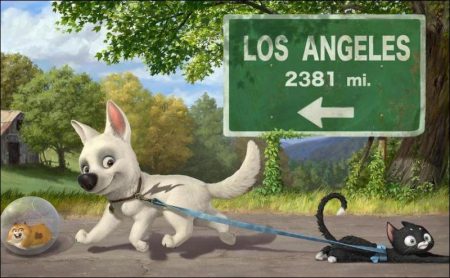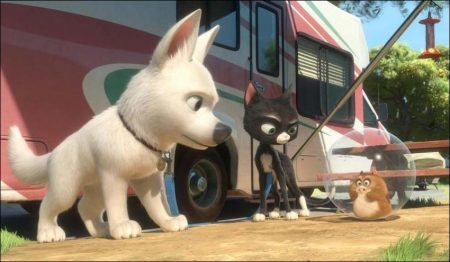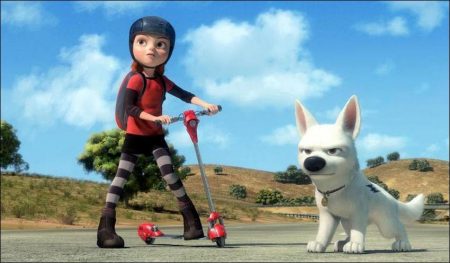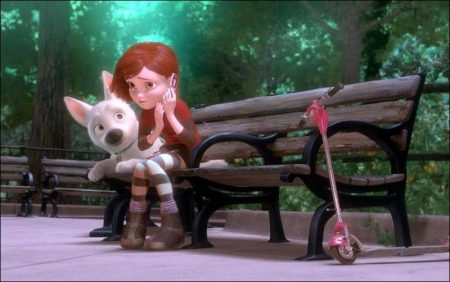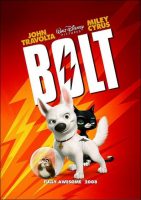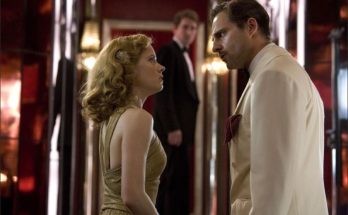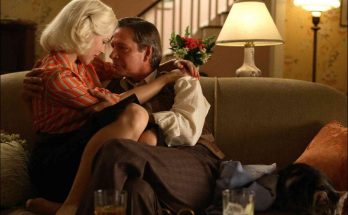Taglines: Fully Awesome. Ridonculous. Let It Begin.
.
For super-dog Bolt (voice of John Travolta), every day is filled with adventure, danger and intrigue-at least until the cameras stop rolling. When the star of a hit TV show is accidentally shipped from his Hollywood soundstage to New York City, he begins his biggest adventure yet-a cross-country journey through the real world to get back to his owner and co-star, Penny (voice of Miley Cyrus).
Armed only with the delusions that all his amazing feats and powers are real, and the help of two unlikely traveling companions-a jaded, abandoned housecat named Mittens (voice of Susie Essman) and a TV-obsessed hamster named Rhino (voice of Mark Walton)-Bolt discovers he doesn’t need superpowers to be a hero.
“Bolt” represents an important turning point for Walt Disney Animation Studios as the first animated feature to be conceived and produced under the guidance of John Lasseter, chief creative officer for Walt Disney and Pixar Animation Studios and the Oscar®-winning director of “Toy Story,” “A Bug’s Life,” “Toy Story 2” and “Cars,” and Ed Catmull, the computer animation pioneer who helped create Pixar Animation Studios and who now serves as president of both Walt Disney and Pixar Animation Studios.
“Bolt” marks the directing debut of Chris Williams (a 14-year Disney veteran who has worked in story and development) and Byron Howard (a Disney animator since 1994 with credits on “Mulan,” “Lilo & Stitch” and “Brother Bear”). Clark Spencer, who produced “Lilo & Stitch” and executive produced “Meet the Robinsons,” as producer. Lasseter is the executive producer. Chris Williams and Dan Fogelman (“Cars”) penned the screenplay; Nathan Greno serves as head of story. The art director is Paul Felix; the director of look and lighting is Adolph Lusinsky.
Versatile composer John Powell, whose credits range from heavy-duty action films (“The Bourne Identity,” “The Italian Job,” “The Bourne Ultimatum”) to popular animated features (“Shrek,” “Horton Hears a Who,” “Happy Feet”), draws on his talents for both. Travolta and Cyrus team up for the original song “I Thought I Lost You” (written by Cyrus and Jeffrey Steele), and popular indie rocker Jenny Lewis wrote and performs the song “Barking at the Moon.”
“Bolt” presented in Disney Digital 3-D at select theaters around the world. Disney Digital 3-D represents the highest standard for moviegoing excellence and takes technology and artistry to exciting new heights. This is Disney’s first 3-D animated film to be created at the Studio and to be conceived and designed from its inception to take full advantage of the increasingly popular medium. Robert Neuman served as the film’s stereo supervisor.
With Humor and Heart, “Bolt” is Born
Filmmakers Join Forces to Create Superdog, Supermovie
At the heart of “Bolt” is a dog who comes nose to nose with a reality he never anticipated. It’s that dog who caught the eye of executive producer John Lasseter.
“The thing that appealed to me most about `Bolt’ from the very beginning was the potential for growth in the main character,” says Lasseter. “To me, that’s where the heart of the film comes from. A purely funny movie without any heart is entertaining, but you quickly forget it. `Bolt’ is so enjoyable and memorable because our hero is a dog who is raised on a movie set and made to believe that world is real. That’s all he knows. When he gets out in the real world and realizes his entire life has been pretend, he embarks on a journey and discovers what it means to be a real dog.”
“I think that for people to love a movie they have to love the characters and care about the relationships,” says director Chris Williams. “So we definitely wanted to make sure that people really loved Penny and Bolt and wanted them to be together. And we had to make sure that as Bolt embarked on his journey and met Mittens and Rhino, that those three characters played off each other well and made people care about their evolving friendships.”
“I’m very proud of `Bolt’ and the fact that it fits the mold of the classic Disney films,” Lasseter says. “The humor doesn’t come just from funny lines. It comes from personalities. That’s the number one thing for me in all of our films. You get these great unique personalities that are funny and appealing, and you put them in funny situations. But along with the humor, you have to have heart. Walt Disney always said, `For every laugh, there should be a tear.’ I believe in that. The heart in `Bolt’ comes from the emotional journey and the change that happens along the way. On top of that, you have to make a film very appealing with the highest quality animation and backgrounds.”
“Chris and Byron have done an amazing job of dividing responsibilities on this film, and communicating with one another to make this an extraordinary film,” says producer Clark Spencer. “They’re both very much involved in the story process, and then Chris oversees editorial, the recording sessions with the actors, and layout. It then passes to Byron who handles all of the animation side. And then it goes back to Chris for lighting and effects.
“Under their guidance, `Bolt’ has turned out to be Disney’s most sophisticated computer animated film to date,” he adds. “Our Studio has taken a massive leap, I think on all levels, whether it’s the way the camera is moving or in the quality of the animation. It’s been really fun to work with Chris and Byron on this terrific project, and in helping Disney set the stage for a new era of innovation and excellence.”
Lasseter concludes, “I believe you need three things done really well to make a successful movie-especially an animated film. You have to tell a compelling story that keeps people on the edge of their seats. You have to populate that story with appealing characters that are memorable. And `appealing’ is the key word there; even the bad guys should be appealing. And then you have to put that story and those characters in a believable world, not realistic, but believable, for the movie and the story that you’re telling. It’s very important that those three things work closely together. You also need to make a connection with the audience-I call it a foundation-which means you need to show them something that they’re familiar with on one level, but then show it to them in a way that they’ve never seen it before. `Bolt’ is a perfect example of this approach.”
Coast-to-Coast Characters
The “Bolt” Lineup
BOLT is a modern-day four-legged action hero and star of his own hit television show, and has been raised on the set to believe that everything that happens in his fictional TV show is real and that he’s been genetically engineered to have amazing powers, including incredible strength, laser vision and a powerful superbark. But when he’s accidentally shipped to New York City, his daredevil stunts no longer go according to plan.
As reality begins to challenge his delusions, Bolt learns that his whole life has been a lie. Or has it? Amidst adversity and hard knocks, he discovers that a dog’s true superpower lies in his loyalty to the owner he loves. Two-time Oscar-nominated actor John Travolta brings just the right blend of toughness, humor and appeal to this fetching performance. The character of Bolt’s design cue is loosely based on American White Shepherds, with changes to the ears, nose and overall body size.
PENNY co-stars alongside Bolt in the film’s fictional TV series. She’s smart and strongwilled, but her relationship to her canine co-star is not merely scripted. When the hectic demands of her acting life get to be too much, she finds solace in the adorable white dog she herself rescued from a shelter years ago. When Bolt disappears, she is devastated and dreams of his return. The multi-talented Miley Cyrus (star of stage, screen and television as the incredibly popular Hannah Montana) brings heart and humor to this winning vocal performance.
MITTENS is an untrusting, streetwise and scrappy New York City alley cat who finds herself at the core of Bolt’s efforts to return home to his Hollywood life and his beloved Penny. Forced to accompany Bolt on his cross-country journey, Mittens’ sarcastic sense of humor and pessimistic outlook provide a sharp contrast to Bolt’s trusting and positive attitude. Mittens proves to be a resourceful traveling companion, and shows Bolt how to survive on the road.
Along the way, however, Bolt’s undying loyalty reawakens something in Mittens and renews her trust in others. Susie Essman (from HBO’s Emmy-winning series “Curb Your Enthusiasm”) lends her vocal talents to this comical and complex kitty.
Sealed within his trusty plastic hamster ball, RHINO is rolling thunder, a pint-sized tourde- force action hero in the making. A diehard super fan of Bolt’s television adventures, this hilarious hamster has memorized every nerdy detail of the dog’s missions and is awestruck when his hero arrives at the doorstep to his RV. Without a moment’s hesitation, he heeds the call of duty, living out his ultimate fantasy by teaming up with Bolt.
When destiny calls, this determined fellow gladly answers, and will stop at nothing to help Bolt succeed. Veteran Disney storyman Mark Walton brings his natural sense of humor and enthusiasm to this ferocious and fanatic ball of fur.
DR. CALICO is a cat-loving criminal mastermind, the villainous star of the fictional TV series. He stirs up new troubles for Penny and her superhero dog in each episode. In the series’ season finale cliffhanger, Dr. Calico kidnaps Penny, and Bolt is-for the first time-unable to come to her rescue. Bolt gets accidentally shipped across the coast believing Penny is still in danger-and that all cats are in cahoots with his nasty nemesis Calico. Malcolm McDowell provides the evil voice of Dr. Calico.
As the auteur and chief creative force behind the popular TV series, THE DIRECTOR jumps through hoops to make sure the show’s top dog believes all the action is real, convinced this makes Bolt’s performances so much more authentic. Prone to taking his job a bit too seriously, he runs afoul of the network executive who is more interested in ratings than making “Citizen Canine.” James Lipton, the charismatic host of the long-running Bravo TV series “Inside the Actor’s Studio,” provides the voice of this dramatic character.
THE AGENT, Penny’s shallow, self-absorbed Hollywood representative, is eager to keep everyone happy so that he can continue to collect his commission. When Penny’s true feelings for her canine co-star get in the way of her performance and threaten to derail the hit series, he encourages his client to “put a pin in it,” and just get on with the show. Greg Germann (“Ally McBeal,” “Quarantine”) provides the voice of this clueless and careless representative.
Give That Dog A Voice
Top Vocal Talent-John Travolta and Miley Cyrus-Help Bring the “Bolt” Characters to Life
Filmmakers knew that the title character of “Bolt” called for a special talent, a voice that could showcase the character’s action-TV persona and his real-world discoveries. They enlisted John Travolta, one of the most enduring and endearing actors working today. “We were really fortunate in having John Travolta voice our main character,” says director Chris Williams. “He is someone who’s had a lot of success playing tough characters in his career. One of the reasons why he’s so good at that is because there is an innate sweet quality in him-as bad and mesmerizing as a character can be, he’s still somehow likeable. This was the perfect combination for playing a dog who thinks that he’s a very threatening, menacing figure, but underneath it all is really a normal loving puppy who loves his owner. It plays to two of John’s biggest strengths. It was a thrill working with an icon who’s been in so many great movies, and I think his performance really brought something special to the character of Bolt.”
According to Travolta, “I had never done an animated feature but when I got the call from [Disney Studio chairman] Dick Cook and he told me that this character really suited my personality, I decided that it was a territory worth investigating. To me, the fun part was seeing how the animators created the dog using my voice, expressions and interpretations. I would experiment and give them 20 or 30 versions of one line. They use their imaginations and artistic skills, and it was the most exciting thing to see the marriage of the two. It turned out great.
“Working with the filmmakers was fantastic and Chris Williams was a revelation to me,” continues Travolta. “His affection for animation was infectious, and I was so tickled by everything we were doing and his choices. The collaborative effort was huge. This guy really knows what he’s doing and had a vision for what the film should be.
“I love that the film has so much heart,” Travolta concludes. “If you’ve ever been separated from your favorite animal, and if you’ve ever loved someone and you miss them, you’re brokenhearted because you can’t be near them. I think audiences will identify in a big way with Bolt and his owner, Penny. It’s a love story, really, and it’s completely entertaining and inviting.”
The inspired casting of Miley Cyrus as the voice of Penny brought a new level of excitement to the project. Aside from being one of the most popular and sought-after talents in show business today, the singer-actress added sincerity and believability to the proceedings.
“One reason I really wanted to do this movie is because I love animals,” says Cyrus. “I have five dogs of my own and I know if one ran away I would not be able to do anything. And that’s the way Penny is. She can’t work. She can’t sleep. She can’t eat.”
Cyrus says she liked the story’s built-in diversity. “It really is an emotional roller-coaster ride. You start out kind of scared of this evil villain, but you’re excited at all of the action in the TV-show sequences. Then you’re sad because Bolt leaves. And then you’re laughing at Rhino.”
Director Byron Howard says, “Miley is incredible and we were so lucky to have her provide the voice of Penny in our film. She brought a real sense of maturity and emotional depth to the role and helped us convey the key story point that Penny loves this little dog and really has his best interests at heart. The audience really needs to feel that her love for him is genuine.”
Director Chris Williams adds, “Miley is a very gifted actor and she was totally invested in the character. Penny has a powerful presence in the film and the role required some very difficult scenes. It was very challenging from an emotional standpoint and Miley pulled it off amazingly well. The scenes between Penny and Bolt have some great interplay and emotion.”
There may be a reason for that. According to Cyrus, she could not only relate to her character Penny, she understood Bolt, too. “In the beginning, Bolt does not want to play. He’s all serious, all business with Penny-always trying to protect her. But Bolt learns that he has to also be a dog. It’s like me-I have to be a kid.”
For the character of Mittens, the filmmakers turned to Susie Essman, a talented comedian and actress perhaps best known as the foul-mouthed no-nonsense wife of Jeff Garlin in the quirky and popular HBO series “Curb Your Enthusiasm.”
“I always wanted to do an animated character, something that my nieces and nephews could watch,” says Essman. “And if you’re an animal lover like me, you believe that animals have emotions. I really do believe that they all have feelings, they just don’t have the power of speech. So it’s been a privilege to give a voice to an animal.”
“The voice of Mittens had to have a depth and warmth to it, and Susie gave us exactly the right mix of being funny with elements of sweetness and vulnerability,” explains Howard.
“Mittens has had a tough and in some ways tragic life, so she’s very guarded.” Adds Essman, “Mittens is such a complicated cat, I just fell in love with her. She has an edge, you know? She’s a tough New York City chick who’s living on her wits and she’s got this sarcastic edge about her. In the beginning, when she thinks that Bolt is nuts, she just sticks it to him. She’s constantly giving him jabs and sarcastic remarks and that’s my thing. I like that.”
“Susie’s performance is very entertaining,” adds director Williams. “You love her when she’s on screen. Her character undergoes a major transformation and another side comes out. She was able to give the character heart, humor and an underlying sense of the pain she’s experienced in life.”
During the development stages of “Bolt,” the filmmakers turned to storyman Mark Walton to do some scratch track recordings for the character of Rhino the hamster.
Says Walton, “It was a lot of fun for me, and we all got a real kick-especially me-hearing my voice saying these really funny lines in the early screenings of the film, but it was generally assumed that, at some point, they would choose a professional actor to record the final voice. But about a year went by, and my voice stayed in screening after screening.”
Director Williams recalls, “Even from our earliest screenings of the story reels, the character of Rhino was playing really well because of Mark’s performance. He has an unbridled energy and is completely comfortable playing the huge extrovert that Rhino is. He was able to channel everything that he is into the character.”
“Rhino needed to be such a fan boy,” adds director Howard. “And you couldn’t ask for a bigger fan boy than Mark. All that enthusiasm that you hear is Mark’s everyday persona. It’s not put-on at all. Every time we’d hear a new recording with him, we’d just crack up.”
“It became clear to us very quickly that he was going to play the hamster and we were very excited to be able to give him the opportunity,” says Williams.
So they planned the perfect way to let Walton know he’d won the job. “The directors brought me down to supposedly re-record an old line,” says Walton. “As I got to the end of the line, I found myself reading into the mic, `And I’m the voice of Rhino!’ After a moment of shock, I totally flipped out.
“Providing the voice of Rhino is a dream come true,” Walton continues. “To be here working on animated films, and then to actually be a character in a film that people will see, remember and want to watch for a long time-it doesn’t get any better than that.”
“Mark’s voice brought so much to the character and gave us a lot to work with,” says supervising animator Clay Kaytis. “He gave Rhino so much energy and humor.”
“Rhino loves television and believes it’s all real,” says Walton. “Bolt is real and everything that happens on the show is real to Rhino. At the recording sessions, they didn’t actually give me a giant ball to roll around in, but they would bring the storyboards and explain what is happening in each scene and what Rhino’s expressions and poses might be. I would imagine myself talking to Bolt or Mittens and it wasn’t too difficult to get into the role. Rhino tends to be very excited and actionoriented. He’s always rolling around and trying to help. I would find myself out of breath and sweaty after several takes. Rhino’s enthusiasm is infectious and it’s hard not to get caught up in it all.”
An inspired piece of casting was having James Lipton, the renowned host of Bravo’s longrunning “Inside the Actor’s Studio,” play the role of the director. As the dedicated director of the “Bolt” TV series, he strives to keep the series’ canine star from discovering that the action going on around him is not real.
Lipton notes, “I’ve always wanted to be in an animated film, and even more, I’ve always wanted to be in a Disney classic. In the Stanislavski system, we want to know what the character wants. In the scenes in which I play the director, I made a note in my head of what he wants to accomplish in the scene. Believe it or not, this is perhaps the first Stanislavski-motivated animated character.”
Rounding out the cast are Malcolm McDowell, who provides the voice of the menacing green-eyed Dr. Calico, villain of the “Bolt” TV series, and Greg Germann, who voices Penny’s opportunistic agent who isn’t particularly sympathetic when Bolt goes missing. Also lending their voices are Randy “Macho Man” Savage, Diedrich Bader and Ronn Moss, star of “The Bold and the Beautiful.”
Pushing the Boundaries of Computer Animation
Animation, Art Direction and Lighting for Bolt
With the voice talent in place, filmmakers turned to the animation team to build the visual elements for “Bolt.” Says director Byron Howard, “The level of animation on this film is pretty stunning, especially with the animals. We did a lot of research to capture the essence of a real dog. The more you believe in these characters, the more you think that they’re not just cartoons moving around on the screen. The more you care, the more your heart goes out to them.”
The canine star of the film was one of the key priorities. For animator Becky Bresee, part of the team that worked on the Bolt character, this assignment was challenging and lots of fun.
“We did lots of research and spent a lot of time observing dogs here at the Studio. I even filmed my own dog at home to study things like how their eyebrows move when they’re looking at something. Puppies and dogs in general tend to be spur-of-the-moment. They’ll just turn on a dime; they’ll be doing one thing and then suddenly they’re off in a different direction.”
Animator Amy Smeed adds, “It was helpful for me to get into that dog mode and get down on all fours to act out being a dog. We had lots of lectures on dog locomotion and behavior, and we had three or four dogs come in so that we could study how they walk and trot, and see their different expressions when they’re happy or angry. John’s voice gave us a lot to work with because it was so expressive with lots of ups, downs and nuances.
“I love animating Penny,” continues Smeed, “She’s one of my favorite characters because she gets to show her action mode as well as her off-screen persona as a girl who loves her little dog. She’s really two different characters and has a lot of heart when she’s not on the set. I love the scenes where she’s playing with her dog. She genuinely cares for Bolt.”
Animating Rhino proved to be one of the most challenging assignments on the film. Supervising animator Clay Kaytis explains, “In the beginning, animating a hamster in a ball seemed so complicated. Every shot required calculating which way the ball would move if he shifted his weight. We had some great software guys who developed a ball that we could basically move around and it would solve the rotation problem. It took a lot of getting used to but luckily we got to a point where each animator could approach it in a different way.”
To help them capture believable movements for the Rhino character, the Studio adopted a hamster named Doink for observation. Doink was filmed from below as he walked on a sheet of plexiglass so that the artists could see how the feet would work in the ball. They were able to study how a hamster twitches and makes hand gestures, and how the ears and nose move.
Unlike many computer-animated films that have a limited number of locations and environments, “Bolt” is a virtual road picture that takes its trio of animal travelers from New York City to Hollywood with colorful detours in Ohio, Nevada and points in between. On top of that, the filmmakers chose a look and style for the film that suggested a looser, more painterly approach. This decision would push the boundaries of the medium and take “Bolt” and company on a journey as colorful as the cast itself.
Director Byron Howard explains, “Paul Felix, our brilliant art director, had the idea of giving the backgrounds a painterly look to soften it. CG is great in a lot of ways, but the thing that it does best is create perfectly straight lines and perfectly curved, smooth surfaces. There can be a tendency for things to look too hard- or clean-edged. So Paul and a bunch of geniuses actually created software to put brushstrokes onto the edges of objects and backgrounds throughout the entire film. It gives the film a warm, lived-in look, and it makes it much more comfortable to watch.”
“Paul’s a big fan of Disney history and he loves the look of the old hand-painted backgrounds,” adds director Chris Williams. “He really wanted to try and get some of that into the CG era. He came up with something very rich and textural for Bolt’s world. It feels very inviting.”
Collaborating with Felix and the filmmakers to create the look of the film was Adolph Lusinsky, director of look and lighting. “Another major influence on us in creating the look for `Bolt’ was some of the early `70s films-especially the groundbreaking work of director Robert Altman and legendary cinematographers Gordon Willis and Vilmos Zsigmond,” says Lusinsky. “They found beauty in natural light. We were interested in presenting our world as it is, instead of something idealized. We mixed the painterly approach with cinematography techniques-lighting, exposure and different lenses-to create a really unique world of textural quality. It feels very tangible and adds a lot of realism.
“A lot of times in CG films, the hard edges can take you out of the picture, so we wanted to add a level of realism by not providing too much detail,” continues Lusinsky. “For example, with computers it’s possible to show bricks on a building going back to infinity; you can count every single brick. In our film, you might see the first few bricks on a wall really clearly, but once you go back 30 feet, it might become very abstracted to a simpler read. This was a completely different approach than we’ve taken before.”
Lusinsky and his team traveled all over the country, including RV parks in Ohio, the desert outside Las Vegas, shipping yards in San Francisco, and the streets of New York City to study lighting conditions and how they might relate to the film. The design and lighting team were able to capture the essence of these locations and put them to use in the film.
Spencer observes, “We wanted the film to have the feel of a live-action film in terms of lighting. Realistic lighting is the key to believability even though our world is caricatured. We didn’t want it to feel like it was manufactured by the computer. “One of the ideas that John [Lasseter] always talks about is creating a believable world,” continues Spencer. “We have a cat, a dog and a hamster living in the real world so we worked hard to create a believable world for our characters that the audience would embrace.”
A New Dimension in Disney Animation
Disney’s First In-House 3D Animated Feature
The Walt Disney Studios has long been a pioneer in technology as it relates to animated films, and that tradition continues with the Disney Digital 3-D™ presentation of “Bolt.” Two previous Disney animated features-“Chicken Little” and “Meet the Robinsons”-were released in 3-D versions, but the 3-D was a post-production conversion process created outside of the Studio. “Bolt” is Disney’s first animated feature to be conceived and designed for 3-D.
To help the filmmakers take maximum advantage of the medium, a depth script was created to chart out the emotional intensity shot by shot, with each scene assigned a value on a scale of one to ten.
“This represents the first time that Disney has created a 3-D film in-house, and at the same time as the actual film,” explains producer Clark Spencer. “As a result, we can actually influence the storytelling through the 3-D process in terms of what’s happening emotionally in the film.
Rather than over-using the technique, we’re able to do something much more subtle and satisfying to the audience. We really wanted to make sure that the storytelling remained our top priority. During an emotional scene, the actual 3-D is toned down in a way that allows you to relax into the moment. For the big action sequences that completely lend themselves to 3-D, we’re able to go all out. It gives us the right balance.”
To help the filmmakers achieve their goals, they enlisted the expertise of Robert Neuman, stereo supervisor. “One of the great things about creating the 3-D version of `Bolt’ as a follow-on process during production is that it allows us to fully integrate into the regular production pipeline,” says Neuman. “It’s allowed us to achieve the best possible results and make the most immersive version of the movie that we can. We take each scene of the film and place it indepth in the theater in such a way as to really bring the audience into it rather than pulling them out with a distracting gimmick. To get the most out of the 3-D experience you have to keep it comfortable. It’s like a marathon runner. You can’t run at a single clip for the whole time or you won’t get to the finish line. We dial up and down to create a truly immersive experience.”
New advances in digital projection have made the 3-D moviegoing experience much more enjoyable and created opportunities for even more immersive filmmaking. Animation is particularly well suited to the process. “One of the big advantages of working in 3-D with animation is the fact that there are no physical form factors to worry about with the cameras,” Neuman says. “We can place our cameras anywhere and have virtually no interocular distance between them if we choose. For example, when Bolt is inside the kennel, we can have our camera in a small space with him without having to worry about the form factor of a stereoscopic camera rig. Also, in animation, the cameras are always perfect and the registration is always spot-on. It’s a huge advantage.”
Making “Bolt” Sing
Composer John Powell and Performances by John Travolta, Miley Cyrus and Jenny Lewis Create a Dynamic Soundtrack
The score for “Bolt” required a composer who was adept at writing music for intense action scenes as well as for the gamut of emotions that are needed for a Disney animated feature. The filmmakers found everything they were looking for with acclaimed composer John Powell.
Clark Spencer explains, “`Bolt’ is really like two movies in one. You have the TV show and then there’s the real world. We needed someone who could compose a theme for that TV show and a whole musicology for what happens on that show, and then music to fit Bolt’s journey.
John has scored big action films like `The Bourne Identity’ and `The Italian Job,’ and has also had phenomenal success with such animated hits as `Ice Age 2.’ He really understands animation and was kind of a natural choice for this film. He’s done an absolutely phenomenal job and I think moviegoers will enjoy and appreciate the transition from TV show to real world. He takes those themes from the TV show and slowly weaves them back into the real world.”
“John’s contribution to the film is incredible,” adds Howard. “He plays both sides of the emotional palette with equal strength. The music for the TV show is super action-oriented with a lot of synthesizer, percussion and some avant-garde musical choices. He’s come up with some great symphonic stuff for the rest of the film that feels more hand-made. It’s more relaxed and more emotional. Music is so important to animated films. With the emotional moments, if you put too much in or too little, you can miss the mark with the audience and they won’t feel it. With John’s music, there are no missed opportunities.”
One of the musical highlights is the original song “I Thought I Lost You,” performed by John Travolta and Miley Cyrus. “I wrote it with one of my buddies, Jeff Steele,” says Cyrus. “We wrote the song to go with the script, but it ended up being so much more.”
“We needed a song that transcended that and could talk about what the journey meant for each of them,” says Spencer. “It’s a very sweet song and it’s not just about these two characters in the film. I think everyone has had that moment in their life where they felt they lost somebody and then they actually came back into their life. This song speaks to everyone.”
Says Cyrus about her singing partner, “It was so fun being able to sing a song with John Travolta. It’s something I’m going to be able to brag about for the rest of my life.”
The film’s soundtrack features a second song called “Barking at the Moon,” which is heard during the film as the unlikely trio of Bolt, Mittens and Rhino travel across the country on their way to Las Vegas. The song is written and performed by Jenny Lewis, a popular indie rock performer who founded and is the co-singer for Rilo Kiley. “Jenny really understood the thematic idea of `Bolt’ and came to us with an amazing demo for her song,” recalls director Williams. “A few weeks later, we were in the recording studio and we got to watch her put the song together. The musician’s creative process felt very much like watching our storyboard artists at work. Jenny is so talented; we’re thrilled to have her as part of the movie.”
Director Howard adds, “The great thing about Jenny’s style of music is that it feels handcrafted. It was the perfect fit for going from the `Bolt’ TV show where we tried to make everything feel aggressive and shiny-to being out in the country where things are more real and homemade. Her music has a true Americana feel to it.”
Bolt (2008)
Directed by: Chris Williams, Byron Howard
Starring: John Travolta, Susie Essman, Miley Cyrus, Mark Walton, Kari Wahlgren, Chloe Moretz, Diedrich Bader, Nick Swardson, Dan Fogelman, Chloë Grace Moretz, Malcolm McDowell
Screenplay by: Luc Besson, Mark Kamen
Production Design by: Tony Fucile
Cinematography by: Scott Beattie
Film Editing by: Tim Mertens
Art Direction by: Paul A. Felix
Music by: John Powell
MPAA Rating: PG for some mild action and peril.
Distributed by: Buena Vista Pictures
Release Date: November 26, 2008
Visits: 85
